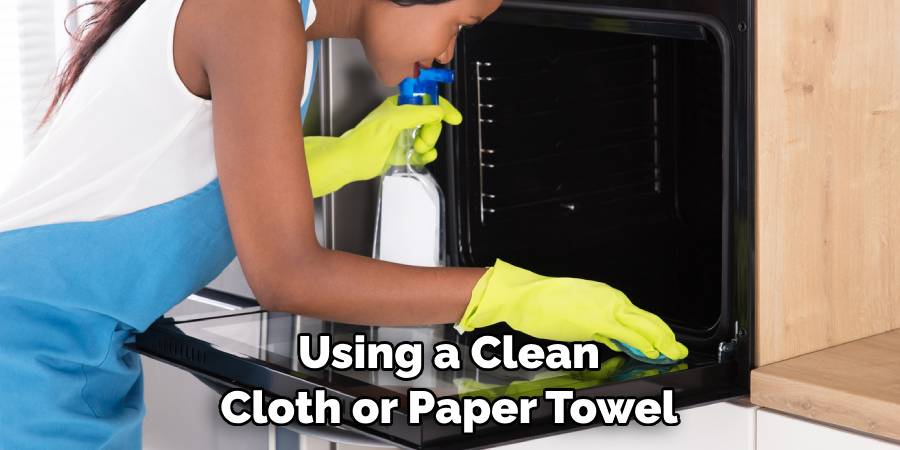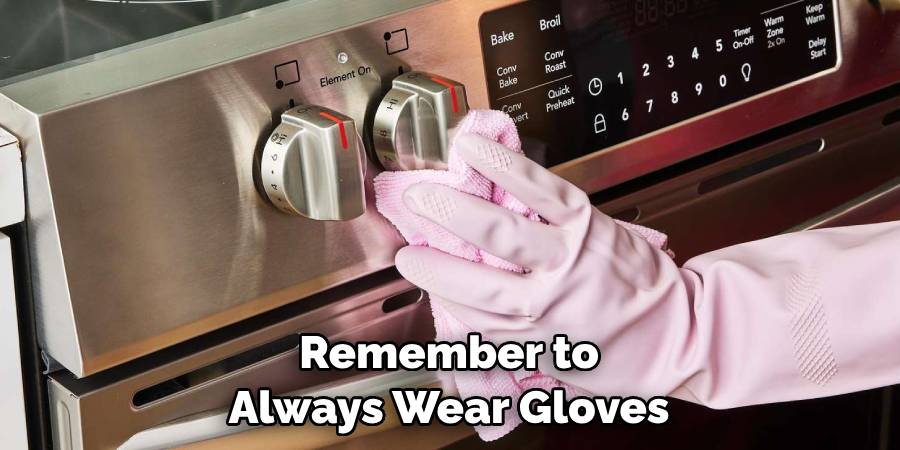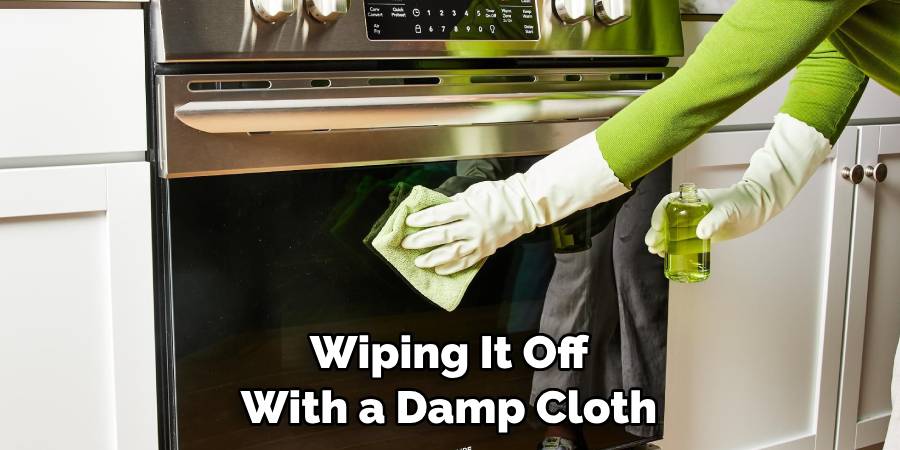Cleaning an oven cover may seem like a daunting task, but it’s essential for maintaining the overall hygiene and functionality of your kitchen.

Over time, grease, spills, and food residues can accumulate, affecting both the appearance and performance of your oven.
This guide will provide step-by-step instructions on how to wash a oven cover to effectively wash your oven cover, ensuring it remains in pristine condition while also extending its lifespan. With the right techniques and cleaning supplies, you’ll find that keeping your oven cover clean can be a straightforward and rewarding task.
Why is It Important to Wash Your Oven Cover?
Before we delve into the steps on how to wash a oven cover, let’s understand why it’s essential to do so.
A clean oven cover not only ensures that your food stays uncontaminated but also prevents any unpleasant odors and smoke from occurring during cooking. Additionally, regular cleaning helps prevent grease buildup, which can be a fire hazard if left unattended.
It’s also crucial to wash your oven cover regularly to maintain its functionality. A dirty and greasy cover can affect the efficiency of your oven, leading to longer cooking times and uneven heating. By keeping it clean, you’ll ensure that your oven operates at its optimal performance, making meal preparation more efficient and hassle-free.
8 Step-by-step Guidelines on How to Wash a Oven Cover
Step 1: Gather Your Supplies
To effectively wash your oven cover, you’ll need the following supplies:
- Dish Soap or Mild Detergent
- Warm Water
- Sponge or Soft Cloth
- Razor Blade Scraper
- Baking Soda
- Vinegar (Optional)
Step 2: Remove the Oven Cover
Most oven covers can easily be removed by simply lifting them out of their designated slots or unscrewing them. If your oven cover is attached with screws, make sure to keep track of them and place them in a safe spot.
It’s also helpful to lay a towel or old cloth on your kitchen counter or floor to protect it from any drips or spills.

Step 3: Scrape off Any Large Debris
Once you have removed the oven cover, inspect its surface for any large debris, such as burnt food or hardened grease. Using a razor blade scraper, gently scrape off any chunky residues, being careful not to damage the surface of the cover. Hold the scraper at a slight angle and use light pressure to avoid scratching.
For areas that are particularly stubborn, you may want to let a mixture of warm, soapy water sit for a few minutes to loosen the debris before scraping. After removing the larger pieces, wipe the surface with a damp sponge or cloth to collect any remaining particles.
Step 4: Soak the Oven Cover in Warm, Soapy Water
Fill a sink or large bucket with warm water and add a few drops of dish soap or mild detergent. Submerge the oven cover in soapy water and let it soak for at least 15 minutes to loosen any remaining debris.
If your cover is particularly greasy, you can also add a cup of vinegar to help cut through the grease. Make sure to wear gloves when handling vinegar as it may irritate your skin.
Step 5: Scrub the Cover with Baking Soda
After soaking, remove the oven cover from the water and sprinkle baking soda over its surface. Using a damp sponge or cloth, gently scrub the cover in circular motions. Baking soda is a natural abrasive and can help remove stubborn stains and grease.
For tougher stains, you can create a paste by mixing baking soda and water until it forms a thick consistency. Apply the paste to the stain and let it sit for 5-10 minutes before scrubbing with a sponge.
Step 6: Rinse Thoroughly
Once you have scrubbed the oven cover, rinse it thoroughly with warm water to remove all traces of soap and baking soda. Make sure there are no leftover residues on the surface as they can cause discoloration or damage over time.
It’s also essential to rinse the cover well to prevent any soapy or vinegar smells from transferring onto your food during cooking.
Step 7: Dry and Reinstall the Oven Cover
Using a clean cloth or paper towel, dry the oven cover thoroughly. Make sure there is no excess water before reinstalling it back into your oven.
If you have a dishwasher-safe cover, you can also place it in the dishwasher for an additional cleaning cycle.

Step 8: Clean Your Oven Interior
Before placing the oven cover back in its designated spot, take this opportunity to give your oven interior a quick wipe-down with warm, soapy water. This will help remove any loose debris that may have fallen during the cleaning process.
Following these steps on how to wash a oven cover regularly will ensure that your oven cover remains clean and well-maintained, making cooking a much more enjoyable experience. It’s recommended to clean your oven cover at least once every month or as needed, depending on how frequently you use your oven.
Frequently Asked Questions
Q: Can I Use Harsh Chemicals to Clean My Oven Cover?
A: It’s not recommended to use harsh chemicals on your oven cover as they can damage the surface and potentially leave harmful residue on your food. Stick to mild detergents and natural cleaning solutions like vinegar and baking soda.
Q: What if My Oven Cover is Too Greasy?
A: If you have a particularly greasy oven cover, you may need to soak it for longer or use a degreaser specifically designed for kitchen appliances. Always read the manufacturer’s instructions before using any cleaning product on your oven cover.
Q: How Often Should I Clean My Oven Cover?
A: It’s recommended to clean your oven cover at least once every month or as needed, depending on how frequently you use your oven. Regular cleaning will help maintain its functionality and appearance, preventing potential hazards and prolonging its lifespan.
Q: Can I Put My Oven Cover in the Dishwasher?
A: It depends on the material of your oven cover. Some covers are dishwasher-safe, while others may be damaged by the high heat and harsh chemicals used in a dishwasher.
Always check the manufacturer’s instructions before placing your oven cover in the dishwasher. Lastly, remember to always wear gloves when handling cleaning products and avoid using metal scouring pads or abrasive cleaners on your oven cover as they can cause damage.

With regular cleaning, you can ensure that your oven cover remains clean and functional, making meal preparation more efficient and enjoyable. Happy cooking!
Frequently Asked Questions
Q: Can I Use Harsh Chemicals to Clean My Oven Cover?
A: It’s not recommended to use harsh chemicals on your oven cover as they can damage the surface and potentially leave harmful residue on your food. Stick to mild detergents and natural cleaning solutions like vinegar and baking soda.
Q: What if My Oven Cover is Too Greasy?
A: If you have a particularly greasy oven cover, you may need to soak it for longer or use a degreaser specifically designed for kitchen appliances. Always read the manufacturer’s instructions before using any cleaning product on your oven cover.
Q: How Often Should I Clean My Oven Cover?
A: It’s recommended to clean your oven cover at least once every month or as needed, depending on how frequently you use your oven. Regular cleaning will help maintain its functionality and appearance, preventing potential hazards and prolonging its lifespan.
Q: Can I Put My Oven Cover in the Dishwasher?
A: It depends on the material of your oven cover. Some covers are dishwasher-safe, while others may be damaged by the high heat and harsh chemicals used in a dishwasher.
Always check the manufacturer’s instructions before placing your oven cover in the dishwasher.
Q: How Can I Remove Stubborn Stains from My Oven Cover?
A: For tough stains, you can use a paste made of baking soda and water to spot-treat the area before scrubbing it with a sponge. You can also try using lemon juice or white vinegar as natural stain removers. Let the solution sit for a few minutes before wiping it off with a damp cloth.

Conclusion
Cleaning your oven cover is a simple yet vital task that contributes to the overall health of your kitchen environment.
By following the aforementioned steps on how to wash a oven cover, you can easily maintain a clean and functional oven cover, ultimately enhancing your cooking experience.
Regular maintenance not only helps prevent unpleasant odors and potential fire hazards but also ensures that your oven operates efficiently.
Make it a habit to clean your oven cover at least once a month, or whenever necessary, to enjoy a hygienic cooking space and improve the lifespan of your kitchen appliances. A little effort goes a long way toward a healthier and more enjoyable culinary adventure.
Professional Focus
Angela Ervin, a former interior designer turned blogger, specializes in kitchen design and renovations. Through her website, she blends her passion for cooking with design expertise, sharing practical and creative ideas. Known for balancing functionality and beauty, Angela’s insightful content has made her a trusted voice in home design and lifestyle.
About the Author
Angela Ervin, an experienced interior designer and blogger, combines her passion for kitchen renovations with storytelling. Living in Petersburg with her family, she enjoys cooking and testing her projects firsthand. Known for her humor and relatable style, Angela shares creative, functional design insights through her content, making her a trusted voice in home design.
Education History
University: Virginia Commonwealth University
Degree: Bachelor of Fine Arts (BFA) in Interior Design
- Angela’s education at VCU focused on mastering core interior design principles, including spatial planning, color theory, materials selection, and sustainable design practices.
- She gained hands-on experience through studio projects and collaborative design exercises, which honed her ability to create functional and aesthetically pleasing environments.
- Her coursework also emphasized problem-solving and practical applications of design, preparing her for real-world projects like her self-directed kitchen renovations.
- The program’s strong foundation in both technical skills and creative expression shaped Angela’s ability to seamlessly integrate form and function in her work.


